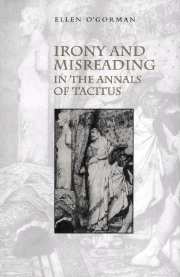Book contents
- Frontmatter
- Contents
- Dedication
- Preface
- 1 Introduction: irony, history, reading
- 2 Imperium sine fine:problems of definition in Annals 1
- 3 Germanicus and the reader in the text
- 4 Reading Tiberius at face value
- 5 Obliteration and the literate emperor
- 6 The empress's plot
- 7 Ghostwriting the emperor Nero
- 8 Conclusion: the end of history
- Bibliography
- General index
- Index locorum
1 - Introduction: irony, history, reading
Published online by Cambridge University Press: 30 September 2009
- Frontmatter
- Contents
- Dedication
- Preface
- 1 Introduction: irony, history, reading
- 2 Imperium sine fine:problems of definition in Annals 1
- 3 Germanicus and the reader in the text
- 4 Reading Tiberius at face value
- 5 Obliteration and the literate emperor
- 6 The empress's plot
- 7 Ghostwriting the emperor Nero
- 8 Conclusion: the end of history
- Bibliography
- General index
- Index locorum
Summary
The ironist aspires to be somebody who gets in on some redescription, who manages to change some parts of the vocabularies being used. The ironist wants to be a strong poet.
Michael Roth, The Ironist's CageSENTENCE STRUCTURE AND HISTORICAL INTERPRETATION
Tacitus is a notoriously difficult writer; the central theme of this study is what the difficulty of Tacitus means and what are the possible ways a reader can respond to this difficulty. Examining what a difficulty means is a rather different action to examining what a difficulty is: in the latter case, we identify difficulty, overcome and disregard it; in the former case we bring it with us, as it were, entering into an ongoing relationship with difficulty. I will argue in this study that what is difficult and obscure in Tacitus' style of writing, what seems to call out for clarification, is central to Tacitus' modality of historical and political thought. In other words, Tacitus conveys to his readers his conception of imperial politics by enmeshing them in ambiguous and complicated Latin sentences. If we decode these sentences and translate Tacitus into clear prose, therefore, we lose the historical representation and analysis of which Tacitus' writing is the vehicle.
- Type
- Chapter
- Information
- Irony and Misreading in the Annals of Tacitus , pp. 1 - 22Publisher: Cambridge University PressPrint publication year: 2000

